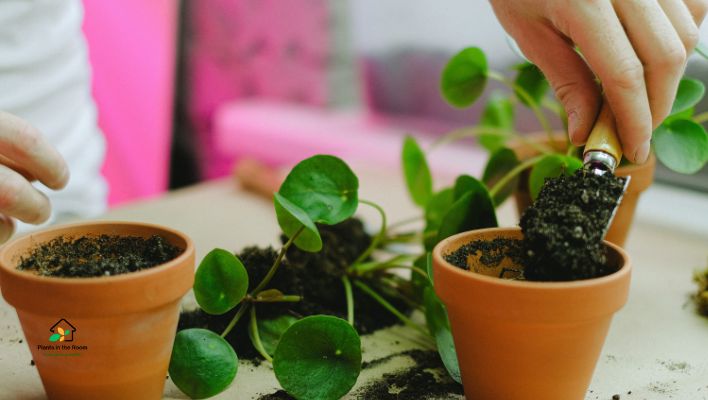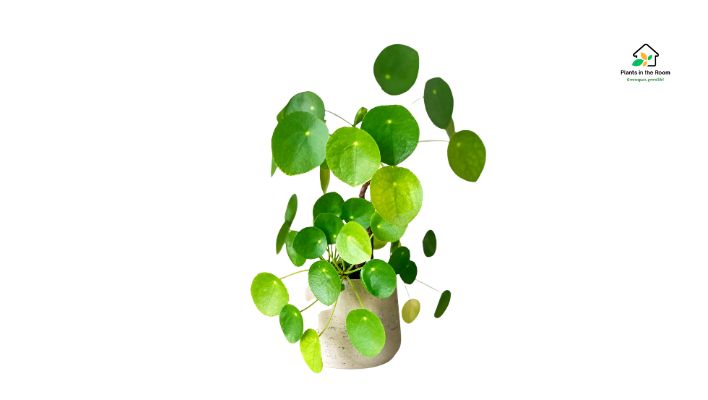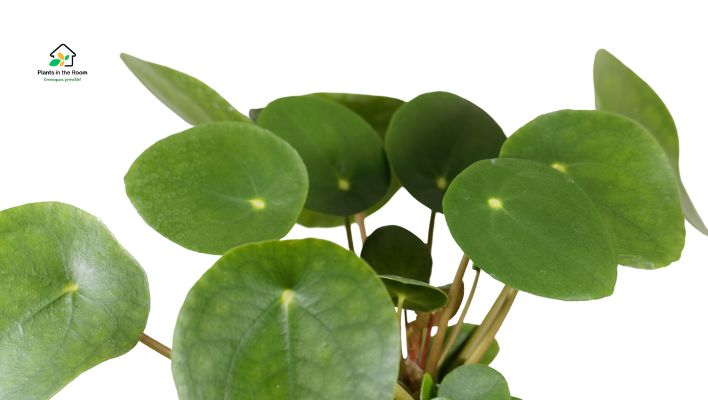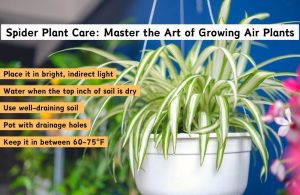This article covers the following areas –
- Understanding the Chinese Money Plant
- The Perfect Spot: Light Requirements
- How to Water Your Plant?
- Optimal Temperature and Humidity
- What Is the Right Soil Mix for Chinese Mony Plant?
- How to Fertilize Your Chinese Money Plant?
- Guide to Propagating Your Chinese Money Plant
- Troubleshooting Common Issues
- Final Note
- Get to Know Your Chinese Money Plant
The Chinese Money Plant, also known as Pilea peperomioides or the “Pancake Plant,” is a popular houseplant prized for its eye-catching, round leaves and easy-care nature. In this article, I’ll explain how to take the best care of your Chinese Money Plant.
Chinese Money Plants prefer bright, indirect light. Keep the soil well-draining & let the top 1-2 inches dry out between watering. They thrive in temperatures of 60-75°F (15-24°C) & moderate to high humidity levels. Fertilize with a balanced liquid fertilizer every 4 weeks during the growing season.
Well! Now, let’s try to find out every aspect of Chinese money plant care. Keep reading the post to keep your plant healthy, and be happy to learn everything you need to do for your Chinese money plant.
Understanding the Chinese Money Plant

Native to the Yunnan Province in China, the Chinese Money Plant has gained popularity worldwide due to its unique appearance and low maintenance requirements. It’s an ideal plant for beginners and experienced houseplant enthusiasts alike.
The plant is known for its coin-shaped leaves that grow on slender stems, creating an appealing, minimalist aesthetic. This charming plant not only adds visual interest to your indoor space but also purifies the air and brings good luck, according to popular belief.
The Perfect Spot: Light Requirements
Chinese Money Plants thrive in bright, indirect sunlight. Place your plant near a window with filtered light, such as a location behind sheer curtains or a few feet away from a sunny window, but avoid direct sunlight, as it can scorch the leaves.
If the plant receives insufficient light, it may become leggy as it stretches to find more light, resulting in a spindly appearance with fewer leaves. Rotate your plant every week or two to ensure even growth on all sides.
How to Water Your Plant?
Watering is a crucial aspect of Chinese Money Plant care. Allow the top 1-2 inches of soil to dry out between waterings, which usually translates to watering every 1-2 weeks, depending on the size of the pot and the environmental conditions.
Water your Chinese Money Plant thoroughly, allowing excess water to drain from the pot. Avoid overwatering, which can lead to root rot, a common issue that can quickly kill the plant.
It’s essential to check the soil moisture with your finger or a moisture meter before watering to avoid overwatering or underwatering.
Optimal Temperature and Humidity
Chinese Money Plants prefer temperatures between 60-75°F (15-24°C) and moderate humidity levels, around 40-50%. Keep your plant away from drafts, air conditioners, and heaters to avoid sudden temperature fluctuations that can stress the plant.
If you live in a dry environment or during winter months when indoor air tends to be drier, you can increase humidity around your plant by placing a tray of water with pebbles near the plant, misting the leaves with water, or using a humidifier.
| Parameter | Chinese Money Plant |
|---|---|
| Preferred Temperature | 60-75°F (15-24°C) |
| Humidity Level | 40-50% |
| Drafts | Avoid |
| Air Conditioners/Heaters | Avoid |
| Methods to Increase Humidity | Tray of water with pebbles, misting, humidifier |
What Is the Right Soil Mix for Chinese Mony Plant?
Choose a well-draining potting mix with good aeration for your Chinese Money Plant. A mix of potting soil, perlite, and peat moss in a ratio of 2:1:1 works well.
This combination ensures that the soil retains moisture without becoming waterlogged, which can lead to root rot. Ensure the pot has drainage holes to prevent water from accumulating at the bottom, which can also cause root rot and other issues.
How to Fertilize Your Chinese Money Plant?
Feed your plant with a balanced liquid fertilizer diluted to half-strength every 4-6 weeks during the growing season (spring and summer). This will provide the necessary nutrients for healthy growth and vibrant foliage.
Reduce fertilizing frequency during fall and winter, when the plant’s growth slows down. Over-fertilizing can lead to excessive growth and weaker stems, so it’s important not to overdo it.
Guide to Propagating Your Chinese Money Plant
Propagation is an exciting aspect of plant care, allowing you to create new plants from your existing Chinese Money Plant. Two common methods for propagating this plant are stem cuttings and separating offsets (pups). Here’s a detailed guide for both methods:
Stem Cuttings
Stem cutting is a popular and effective technique for multiplying various types of plants, including the Chinese Money Plant. This method involves taking a healthy cutting from the parent plant and encouraging it to develop roots, eventually forming a new, independent plant.
Here, we’ll delve into the stem-cutting propagation process, providing you with all the steps and tips to successfully create new Chinese Money Plants from your existing ones.
Step 1: Choose a Healthy Stem
Look for a healthy stem with several leaves, ideally, one that is mature but still relatively young. A good candidate for cutting should have a vibrant green color and show no signs of disease or pest infestation.
Step 2: Take the Cutting
Cut the chosen stem about an inch below a leaf node (the point where the leaf connects to the stem) with a clean, sharp pair of scissors or a knife. Make sure to sterilize your cutting tool before use to prevent infection.
Step 3: Prepare the Cutting
Remove the leaves from the bottom inch of the stem to create a clean surface for root growth. Optionally, you can dip the cut end of the stem in a rooting hormone to encourage faster root development, but this is not necessary for success.
Step 4: Root the Cutting
Place the prepared cutting in a container filled with water or damp, well-draining soil. If using water, change it every few days to keep it fresh and prevent bacterial growth. If rooting in soil, make sure to keep the soil consistently moist but not waterlogged.
Step 5: Monitor and Transplant
In a few weeks, you should see new roots developing. Once the roots are a couple of inches long, you can transplant the cutting into a pot with the appropriate soil mix. Continue to care for the new plant as you would with a mature Chinese Money Plant.
Separating Offsets (Pups)
An alternative to stem-cutting propagation, the offsets or “pups” method is another effective way to create new plants from your existing Chinese Money Plant. This approach involves identifying and separating the baby plants, or pups, that grow naturally alongside the mother plant.
Now, we’ll explore the pups propagation process, a step-by-step method to successfully propagate Chinese Money Plants by separating offsets and nurturing them into mature, independent plants.
Step 1: Identify the Pups
Pups are baby plants that grow at the base of the mother plant. They will appear as smaller versions of the Chinese Money Plant, with their own root system.
Step 2: Gently Separate the Pups
Carefully remove the mother plant from its pot and gently tease apart the root ball to reveal the pups. Using your fingers or a clean, sterilized tool, separate the pups from the mother plant, ensuring that each pup has some roots attached.
Step 3: Plant the Pups
Prepare a pot filled with the same well-draining soil mix used for the mother plant. Plant each pup in its own pot, positioning it at the same depth it grew alongside the mother plant.
Step 4: Care for the New Plants
Water the newly potted pups and place them in a bright, indirectly lit location. Maintain proper watering and care, and watch as they grow into mature Chinese Money Plants.
Troubleshooting Common Issues

Chinese Money Plants are generally low-maintenance and disease-resistant, but they can still face issues affecting their health and growth. Here are some common problems you may encounter.
1) Pest Infestations
Look out for signs of aphids or spider mites, such as webbing or tiny insects on the leaves. These pests can damage the plant by feeding on the sap, causing yellowing and curling of the leaves. Treat any infestations with insecticidal soap or neem oil, following the manufacturer’s instructions.
2) Yellow Leaves
Yellowing of the leaves can occur for several reasons, including overwatering, underwatering, or exposure to direct sunlight. Check the soil moisture level and adjust your watering schedule accordingly, ensuring that the soil is moist but not waterlogged. If the yellowing persists, move the plant to a brighter location with indirect sunlight or adjust the temperature to avoid exposure to direct sunlight.
3) Drooping Leaves
Drooping leaves can be a sign of underwatering, overwatering, or exposure to excessive heat. Check the soil moisture level and adjust your watering schedule accordingly, ensuring that the soil is consistently moist but not waterlogged. If the soil is dry, water the plant thoroughly and make sure that excess water drains away. Ensure that your plant is not exposed to extreme temperatures or drafts, which can stress the plant and cause leaves to droop.
4) Leaf Curling
Leaf curling can occur for several reasons, including low humidity levels, pests, or exposure to direct sunlight. Increase humidity levels around your plant by misting the leaves or using a humidifier, and treat any pest infestations promptly. If the issue persists, move the plant to a brighter location with indirect sunlight or adjust the temperature to avoid exposure to direct sunlight.
5) Brown Leaf Tips
Dry, brown leaf tips may indicate low humidity levels or over-fertilization. Increase humidity levels by using a humidifier, placing a tray of water with pebbles near the plant, or misting the leaves. Ensure that you’re using the right amount of fertilizer, as over-fertilization can cause burning of the roots and brown leaf tips.
By being attentive to your Chinese Money Plant’s needs and addressing any issues promptly, you can ensure that it thrives and adds a touch of greenery to your indoor space.
Final Note
With proper care and attention, your Chinese Money Plant will reward you with an eye-catching display of lush, round leaves. By following the guidelines presented in this article, you can ensure your plant stays healthy, happy, and beautiful for years to come.
The Chinese Money Plant is a charming addition to any indoor space, providing a touch of natural beauty and good luck while purifying the air. So, enjoy watching your plant flourish as you become an expert in its care!
Get to Know Your Chinese Money Plant
| Indicator | Chinese Money Plant |
|---|---|
| Family | Stinging Nettle family (Urticaceae) |
| Genus | Pilea |
| Species | P. peperomioides |
| Common Name | Chinese Money Plant, Pancake Plant |
| Origin | Southwestern China |
| Plant Type | Perennial, Indoor Plant |
| Mature Size | 8-12 inches in height |
| Growth Rate | Fast |
| Light Requirements | Bright, indirect light |
| Watering Requirements | Moderate, allow top 1-2 inches of soil to dry out between watering |
| Soil Preference | Well-draining, fertile soil |
| pH Preference | 6.0-7.0 (Neutral to slightly acidic) |
| Temperature Tolerance | 60-75°F (15-24°C) |
| Humidity Tolerance | Moderate to high humidity (40-50%) |
| Fertilization | Balanced liquid fertilizer every 4 weeks during growing season |
| Propagation | Stem cuttings, separating offsets (pups) |
| Pests | Mealybugs, spider mites |
| Diseases | Root rot, leaf spot |
| Toxicity | Non-toxic to humans and pets |
| Special Features | Air-purifying, unique, round leaves |
| Popular Uses | Indoor houseplant, desk plant, gift plant |
If you have any questions or tips on caring for Chinese Money Plants, feel free to share them in the comments below!






